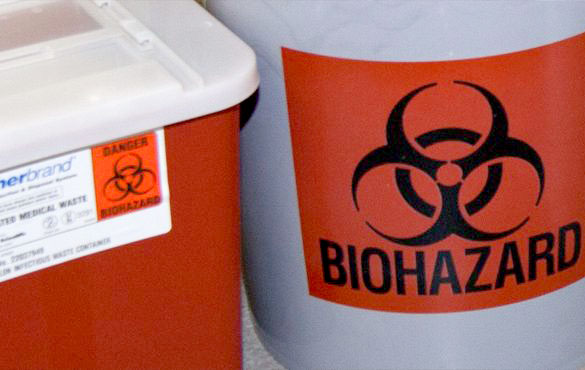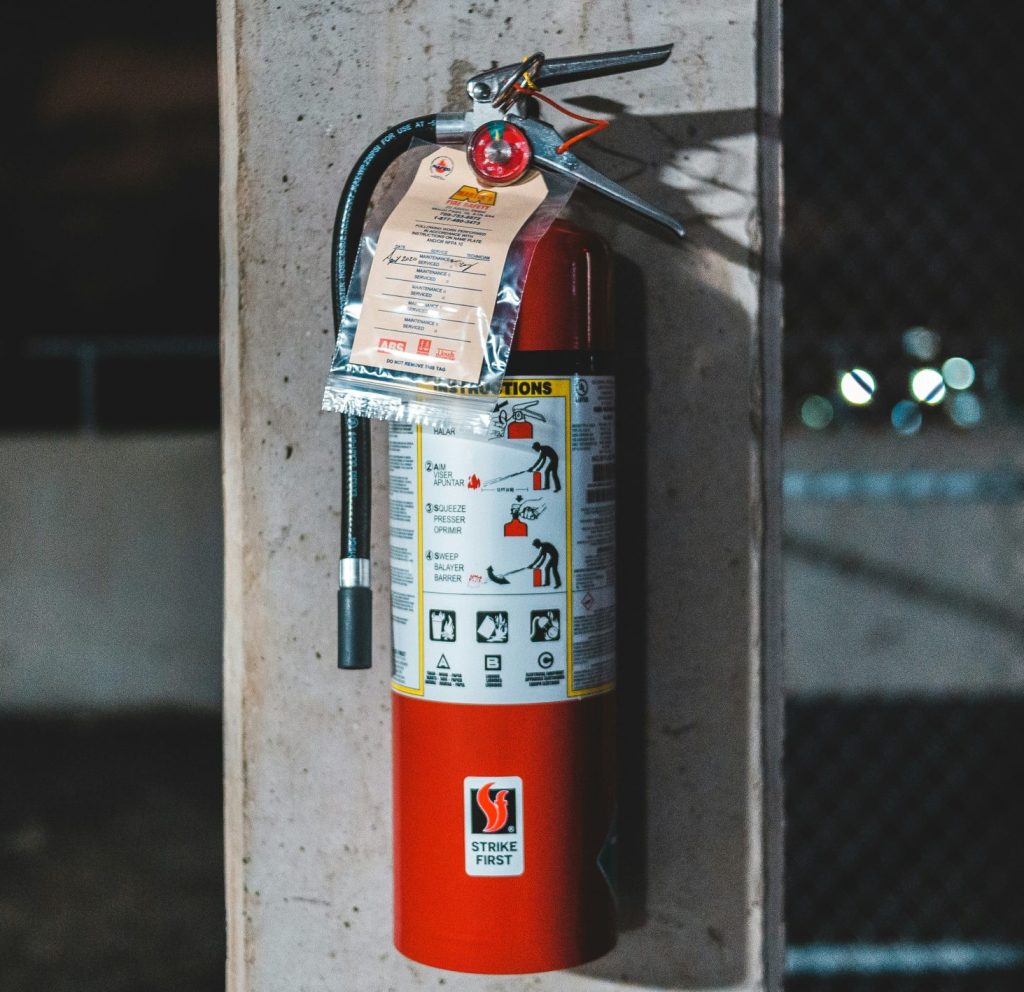Transporting Biological Materials
The movement of potentially hazardous substances including infectious agents, chemicals, or research animals can fall under various federal and state regulations. The University of Michigan (U-M) has put into place restrictions on the movement of these materials on university modes of public transportation such as the U-M buses, where individuals unfamiliar with the materials may be potentially exposed or have the perception of exposure.
| INFECTIOUS SUBSTANCE OR HAZARDOUS MATERIAL | DEFINITION |
| Category A | An infectious substance which is transported in a form that, when exposure to it occurs, is capable of causing permanent disability, life-threatening or fatal disease in otherwise healthy humans or animals. |
| Category B | An infectious substance which does not meet the criteria for inclusion in Category A. This can be human, animal, bacterial, viral, or fungal material transported for research, diagnosis, disease, or treatment. |
| Patient/Animal Specimens | Patient and animal specimens for which there is minimal likelihood that pathogens are present. |
| Chemical Preservatives (Dangerous Goods in Excepted Quantities) | Biological specimens containing chemical preservatives such as ethanol, formaldehyde, or formalin. |
| Dry ice | Frozen carbon dioxide that sublimates into gas. |
The following substances are not required to follow the IATA or DOT regulations, but are still subject to U-M restrictions on moving materials around campus:
- Materials that do not contain pathogens or only contains inactivated or neutralized pathogens
- Environmental samples that do not pose a significant threat of infection (i.e, food, water soil, or dust samples)
- Dried blood spots or fecal occult screening tests
- Blood or blood components collected for the purpose of transfusion
- Tissue or organs used for transplantation
- Patient specimens
If you are not sure how to classify your materials or need additional information on shipping biological materials, please contact EHS Biological Safety for assistance at (734) 647-1143 or EHSBiosafety@umich.edu
The M-Ship Shipping Service prepares packages of biological materials, including dry ice, for shipping for U-M research faculty and staff. The shipping consultants at M-Ship will also prepare the appropriate documentation and paper work, including the commercial invoices required for international shipment.
There are three MShip locations. They are located at Dock 90 at NCRC, Dock 6 at MSRB II and Dock 7 at BSRB. Researchers may drop off their materials or the shipping consultants can pick up the materials at the lab location.
This service, along with the dry ice, standard packing materials, and labels are of no cost to your department. However, each department is required to pay for the courier shipping fee; and personnel are required to complete the appropriate training courses to better communicate to the consultant the hazards and classification of the biohazardous substance or hazardous material.
Select the appropriate course below based on the material you intend to ship:
- BLS204w – Requirements for Shipping Non-Dangerous Goods with Dry Ice This course fulfills the requirements for: Shipping materials with dry ice with no other hazardous or biological materials included in the shipment.
- BLS209w – Regulations for Shipping Biologics: Infectious Substances Category B This course fulfills the requirements for: Shipping infectious Substances Category B, Dry Ice, certain Chemical Preservatives, Exempt Specimens, and Genetically Modified Organisms (GMO). Note: BLS209w – Category B training fulfills the requirements for most U-M shipments.
NOTE: Each course selected must be documented and completed every two years.
For more information, refer to one of the following resources:
- Navigate to the M-SHIP Web site
- Send an email to shipping@umich.edu
- Call (734) 763-8786
- EHS Contact 734-647-1143
Required Courses
Personnel who prepare biological materials for shipment, or will transport or receive biological material shipments, must be trained and certified by EHS. In addition, they must maintain a copy of the training certificate (you can print a copy of your training certificate from My LINC). The following courses are required, as appropriate, for each person engaged in shipping hazardous materials. These courses must be taken every two years.
- BLS204w – Requirements for Shipping Non-Dangerous Goods with Dry Ice This course fulfills the requirements for: Shipping materials with dry ice with no other hazardous or biological materials included in the shipment.
- BLS209w – Regulations for Shipping Biologics: Infectious Substances Category B This course fulfills the requirements for: Shipping infectious Substances Category B, Dry Ice, certain Chemical Preservatives, Exempt Specimens, and Genetically Modified Organisms (GMO). Note: BLS209w – Category B training fulfills the requirements for most U-M shipments.
The Packaging Requirement for Biological Substances and Hazardous Materials document provides information about packaging hazardous substances and materials for shipment. You may print individual topics from this document, which are in the following list:
- Minimum Requirements for Securing Biological Substances and Hazardous Materials
- Classification Guide for Infectious and Biological Substances
- Category A Infectious Substances
- Category B Substances
- Exempt and Unregulated Specimens
- Genetically Modified Micro-Organisms and Genetically Modified Organisms
- Biological Specimen Containing Chemical Preservatives
- Packaging Requirements for Category B, Exempt, Unregulated, and Genetically Modified Substances
- Packaging Requirements for Dry Ice
- Printable Labels
Import, interstate movement, and export of infectious agents and/or biological materials are tightly regulated by Federal agencies and may require permits. These permits minimize the risk of inadvertent release and inappropriate use of such materials. Compliance with multiple regulatory agencies may be required in some cases, depending on the nature of the material to be transported, the point of origin, etc.
Permits are issued to the individual, and not to the institution.
The PI or the recipient is responsible for applying for the permit and obtaining it prior to receipt of the material. The permit application process may take several weeks, and sufficient processing time must be allowed before securing the materials needed. Additionally, the permit holder is responsible for adhering to the conditions outlined in the permit, including transport and transfer of materials. If you are shipping material that requires a permit from the recipient, a copy of the permit must be obtained from the recipient and included with the shipment. Failure to comply with regulations when transporting regulated biological materials may result in shipment delays or destruction at the port of entry, refusal of the shipment by carriers, and be subject to fines and/or criminal penalties.
Permits-CDC
Centers for Disease Control and Prevention (CDC) Etiologic Agent Import or Transport Permits
CDC Import Permit regulations govern the importation of infectious biological agents, infectious substances, and vectors of human disease into the United States. A CDC Import permit is required prior to importing the following materials into the United States:
- Infectious biological agent (e.g., bacteria, viruses, fungi, prion, etc.)
- Infectious substance or any material that may potentially contain an infectious biological agent
- Vector – Any arthropod or other animal host or vector of human diseases, or any non-infectious self-replicating system capable of transferring an infectious biological agent to a human
- Animals, Arthropods, Snails, Bats
- Non-human primate material (all non-human primate material, unless it has been specifically treated and rendered non-infectious, in which case documentation of the treatment method may need to be provided)
A CDC import permit may not be required in certain cases (e.g. a diagnostic specimen that does not contain an infectious biological agent, a biological agent that has been rendered non-infectious, nucleic acids that cannot produce infectious forms of any infectious biological agent). To facilitate clearance of materials that do not require a CDC import permit, a certification statement on university letterhead, from the sender or the recipient of this material must accompany the shipment. The certification statement must include:
- Statement affirming
- A detailed description of the material.
- The material is not known or suspected to contain an infectious biological agent, and
- One of the following:
- How the person knows that the material does not contain an infectious biological agent *, or
- Why there is no reason to suspect that the material contains an infectious biological agent, or
- A detailed description of how the material was rendered noninfectious.
*Note if the material is infectious – an Import Permit is required.
CDC Certification Letter Template – Exempt Human Specimen
Additional information on what to include in the certification statement can be found at the CDC IPP website.
CDC Import Permit Application Process
There is no fee associated with obtaining a CDC import permit.
Before importing an infectious biological agent, infectious substance, or vector into the US, the recipient must:
- Determine if the shipment requires a permit. The CDC’s e-Tool is a helpful in determining whether an import permit is required. For general questions related to the CDC Import Permit Program (IPP) contact their office via phone at 404-718-2077 or email importpermit@cdc.gov.
- If the shipment requires a permit, visit the CDC IPP website to complete the permit application. Make sure to indicate Janet Follo follo@umich.edu as the Biosafety Officer for the U-M in the application.
- After the permit is issued, ensure that a copy of the permit is retained by the shipper and receiver, and that the shipment is accompanied by the applicable permit.
- Ensure that the shipper and recipient are in compliance with all legal requirements including all packaging and labeling requirements by a certified IATA shipper.
- Ensure that adequate biosafety measures are in place for storage and use of the regulated agent.
- Ensure compliance with all permit requirements and conditions as long as you are in possession of the imported material.
- It is advisable to maintain all shipping records as long as you are in possession of the imported material.
In some cases, a site inspection may be required prior approving an import permit. If a site inspection is required, CDC will provide an initial notice of inspection and coordinate the visit with the permittee. The purpose of these inspections is to verify the implementation of adequate biosafety measures and may include (but not limited to) evaluation of documentation, safety equipment, practices and procedures that are in place, and the structure and features of the facility. A representative of EHS must be present at such inspection. Accordingly, please contact EHSBiosafety@umich.edu to assist with the inspection process. If no further information is required after the inspection, an inspection report will be provided, and the permit will be processed and approved.
Permit holders must be aware of all permit conditions in the issued document. A separate CDC authorization or permit may be required for the subsequent transfer or distribution of agents within the US, if noted as a condition of the issued permit. A copy of the permit must be included with the shipment.
Additional Transfer Restrictions For Certain Agents
The CDC has additional transfer obligations and requirements for permit holders of the following agents:
- Sars-CoV-2
- Polio
- MERS
- Influenza (H7N9)
- Influenza (H6M1)
- Influenza (H2N2)
- Monkey Pox (M-Pox)
As one example, a separate CDC authorization, which includes listing the named permit holder at the University of Michigan as a sender on the receiving institution’s permit, is required for the subsequent transfer or distribution of the above-listed agents.
General Permit Conditions and Amendments
Once a permit is granted, proper use, possession and disposal of the regulated material is the responsibility of the permittee.
It is recommended that a separate Standard Operating Protocol (SOP), detailing handling and work practices, is maintained for each regulated material. This SOP may be required by the regulatory agency during a site inspection. The SOP must list the physical containment and specific operational standards for the regulated material, include information on handling regulated waste, decontamination techniques including autoclaving (how and when the autoclave is tested to ensure adequate sterilization, how and where an autoclave activity log is maintained, how the material is transferred from one room to another if the autoclave is located in a different room), etc.
Permits are valid only through the time period indicated on the permit. Although certain permits may not need to be renewed for continued storage, permit conditions will remain in effect for all regulated material as long as the permittee is in possession of the material. Permit conditions will not expire until the regulated material is used up, appropriately disposed of, or destroyed.
If permit conditions state that a valid permit must be maintained so long as the regulated material is possessed, the permittee must renew the permit, even though the material may no longer require transport. It is recommended that the permittee start the renewal process at least 3 months in advance to allow adequate time for processing. If the material is no longer required, the lab should close out the permit.
Unless specifically mentioned under permit conditions, CDC and USDA Veterinary Services does not regulate the intrastate movement of most regulated material, though it may fall under state/local regulations. However, if regulated material is transferred to another researcher within the state or the institution, the permittee is still legally responsible for the material’s use, possession, and disposal. Hence, EHS recommends that each recipient obtain his or her own permit before any material is transferred
If a permit indicates USDA/APHIS inspected the facility/rooms, it is required that all work be conducted in only those approved rooms.
An amendment to the existing permit is required if the permit details change (including name, address, laboratory information or the regulated material description).
USDA and CDC transport permits are issued to a specific individual and not to the laboratory or the institution. Hence, if the permittee leaves the University, it is important to close out the existing permit, and reapply for a new permit if the lab intends to continue working with the regulated material. For this reason, it is recommended that the Principal Investigator (PI) serve as the responsible party, even though the permit may be issued to any eligible lab personnel.
A new permit application must be submitted if the permittee leaves the University and wishes to transport the material to another institution.
Please note that permit close out is not the same as expiration of a permit. The permittee is still legally responsible for the use, possession and disposal of the regulated material as indicated in the permit conditions, even after a permit expires.
If a permit is closed out, the regulatory agency may conduct an inspection to ensure the lab adhered to all permitting conditions of the regulated material. It is advisable to maintain a copy of the permit and document the method of destruction even after the regulated material has been disposed.
Other Relevant Regulatory Agencies
In addition to the applicable USDA APHIS VS permits, US Fish and wildlife CITES (Convention on International Trade in Endangered Species of Wild Fauna and Flora) permits may also be required for certain live animals, including bats. Materials from certain endangered species that is CITES listed, such as Vero cells (established from Adult African Green Monkey kidney cells) also requires a CITES permit before it is imported into the US.
For example, a USDA APHIS VS permit is not required for the importation of Zika virus into the US (unless it has been exposed to animal products). However, if the virus is cultured in VERO cells, a CITES permit is required.
Federal export control regulations prohibit the export of certain biomaterials to foreign countries without an export license issued by the government. The Export Administration Regulations are administered by the US Department of Commerce. For more information, Email the Export Control Office at exportcontrols@umich.edu
Involvement of University of Michigan EHS
If the permitting agency requests a site inspection prior to approving the permit. Please contact EHSBiosafety@umich.edu to assist with the inspection process.
Additional Resources
Do I Need a CDC Import Permit – https://www.cdc.gov/import-permit-program/php/etool/index.html
CDC Video: Importing Biologics and Vectors – Know Before You Go
2021
Biological substances can be transported (hand-carried or by vehicle) between labs, building floors, and building on the U-M campus. Biological substance include any materials taken from humans or animals, living or dead, fresh or preserved (cells, tissues, organs, blood and body fluids), cultures, suspensions or lyophilized prokaryotic or eukaryotic microorganisms, viruses, sub-viral particles, recombinant products, or parasites used for teaching or research purposes.
Biological substances must be placed in three different packages when being transported, by hand-carry or vehicle, to a new location. The following table describes each type of packaging:
| PACKAGING | EXAMPLES | DESCRIPTION |
| A leak proof primary receptacle |
| Primary receptacles must be able to be secured with a lid or sealed with a screw top lid or with tape or parafilm. NOTE: Liquid samples must be surrounded by absorbent material (absorbent towels) to contain the total volume of the liquids and absorb any shock during transport. |
| Leak proof secondary packaging |
| The secondary package must be sealed so that it will not open and spill the contents during transport. |
| Outer Container |
| The outer container must be adequate in strength and have a secure lid. |
Label exterior container with:
- Contact information for responsible person/lab:
- Name, phone, lab name/location
- If moving between buildings, include lab or building address.
- Brief description of materials and handling information applicable to your materials Examples for labeling:
- Biological Research Samples
- Research Samples
- Non-Infectious Animal Specimens for Research
- Diagnostic Specimens
- Labels must be legible and durable (water resistant is recommended)
- Disinfect exterior of container prior to transport to remove any potential contamination acquired during packing in the lab
Use the following precautions when hand-carrying biological substances on the U-M campus:
- When possible, use a cart to move the biological substances
- Take care when moving materials through public spaces or high traffic walkways
- Do not wear laboratory gloves in public access areas
- Carry a spill kit of gloves, lab coat, eye wear, disinfectant, and absorbent material during transport to clean up any spills that may occur
NOTE: Contact EHS at (734) 647-1143 if assistance is needed to clean up a spill.
Transporting Biological Substances in a Vehicle
U-M recommends using the following transportation services to transport biological material on U-M campus:
- The Bio Research Shuttle
- Commercial or private carriers (i.e., commercial transport companies). NOTE: Commercial transport companies are subject to the Hazardous Materials Regulations. These include companies such as UPS, FedEx, as well as medical couriers Metro Delivery, Unity Lab Services, etc.
- Personal vehicle – WARNING: U-M does not recommend transporting biological substances in personal vehicles. If this option is used, the driver must be notified that biological substances are in the container and must be informed of the requirements in this section.
Accidents during movement or transportation of any of these materials can potentially result in serious harm to persons and property. Release and spills of these materials may involve police and EHS Hazardous Materials Management responders including clean-up and cost of recovery.
Personnel who prepare biological materials for shipment, or will transport or receive biological material shipments, must be trained and certified by EHS. In addition, they must maintain a copy of the training certificate (you can print a copy of your training certificate from My LINC). The following courses are required, as appropriate, for each person engaged in shipping hazardous materials. These courses must be taken every two years.
| COURSE NUMBER | PERSONNEL WILL BE QUALIFIED TO: |
| BLS204W | Handle, package, and ship materials refrigerated with dry ice. NOTE: This course is intended for those shipping non-regulated materials but using dry ice. |
| BLS209W | Prepare and ship packages containing exempt specimens, genetically modified organisms (GMOs), and category B substances. Information on shipping these materials with dry ice and chemical preservatives is also included in this training. |
Dry ice is classified by DOT and IATA as a “miscellaneous” hazard, Class 9. Dry ice is considered hazardous during transportation for the following reasons:
- Explosion hazard: dry ice releases a large volume of carbon dioxide gas as it sublimates. If packaged in a container that does not allow for release of the gas, it may explode, causing personal injury or property damage.
- Suffocation hazard: a large volume of carbon dioxide gas emitted in a confined space may displace oxygen and create an oxygen deficient environment.
- Contact hazard: dry ice is a cryogenic material that causes severe frostbite upon contact with skin.
For information about packing dry ice, in which no other biological substances will be packaged, refer to the document Packaging Requirements for Dry Ice.
For information about packing biological substances with dry ice, refer to the document Packaging Requirements for Biological Substances and Hazardous Materials.
If you ship biologics frequently, it may be cost-effective for you to order your supplies from vendors that sell UN certified biological shipping systems.
If you ship biologics occasionally or on a limited basis, it may be cost-effective for you to get your shipping system supplies from EHS at cost. All you need to do is complete the UN Certified Biological Shipping Systems Available form. NOTE: You must complete the appropriate shipping biological material training course before you ship.





